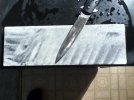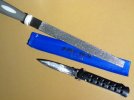For freehand sharpeners, I'd like to hear in detail what sharpening stroke/movement that you prefer, and why. As I'm learning, I keep trying and adapting so it's useful to hear what other folks have landed on and how you got there.
Stuff I'd like to know:
What I'm currently doing:
Stuff I'd like to know:
- Shaping: What type of movements you use to scrub/shape a blade, reset bevels, profile an edge. How you position the stone. And whether you change hands.
- Sharpening: What type of movements do you use to apex and refine a blade. How you position the stone. And whether you change hands.
What I'm currently doing:
- Shaping: Position the stones lengthwise to myself and scrub always with the edge facing away, and change hands to work both sides. Type of movements: back-and-forth scrubbing motions of a few inches. Occasionally punctuated by a long scrub nearly the length of the stone, or occasional slices/strokes to help blend the bevel. I use both hands, not the one-handed type of motion that for example Cliff Stamp uses in his videos.
- Why: I found it easier to shape using the same method, going the same direction, even though I had to change hands. The movements are similar, and visually, it's more consistent as well. Also this is more of a gross (rather than fine) type of motor control for this sharpening motion, I found that changing to my off-hand doesn't impact my results negatively at this stage.
- Sharpening: Keep the stone in the same lengthwise position. I use edge-leading slicing motions running either heel-to-tip, or smaller sections that need work. When I change sides during sharpening, now I stick with my dominant (left) hand so that on one side of the blade, that means I am slicing back towards myself on the stone.
- Why: I tried alternating hands with all slices going away from myself as during the shaping stage. Trying to be a true "ambidextrous" sharpener. I tried and tried for months, but could not get equal/consistent results on my off-hand. To get the same level of precision and control, and consistent results as the sharpening stage, it requires finer motor control and I had to resort to using my dominant (left) hand 100%.


